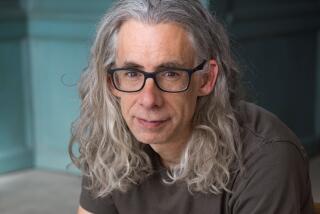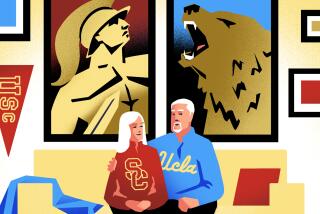Those left hanging
HAS THERE ever been a more salacious subject than polygamy? The very thought of the harem -- one husband, three or four wives, or in the case of certain Mormon settlers, 15 or 20 -- sets the imagination perking. The first wife might be a seasoned crone of 70, the last a nubile lass of 13, and in between a veritable female stable.
The nonstop media coverage of the raid earlier this year on a polygamist compound in Texas and the success of HBO’s “Big Love” are proof the public can’t get enough of polygamy, in spite of its tawdry aspects (including incest and child molestation). Mainstream Mormons, of course, just wish the subject would go away. It’s always been the monkey on their back, making them seem even more like outsiders. In the 19th century, Mormons were sometimes referred to as “white Muslims” because they were thought to keep harems and had their own bible -- the Book of Mormon -- a tome that Mark Twain (wag that he was) found so unreadable he called it chloroform in print.
Mormons rejected polygamy in 1890, forced by Washington, D.C., to choose between statehood for Utah and their “Divine Principle.” Nevertheless, polygamy has continued to flourish among the Fundamentalist Church of Jesus Christ of Latter Day Saints, an offshoot Mormon sect known as the FLDS, whose members have holed up in remote settlements in the American West, Mexico and Canada, where they have been allowed to do whatever they want, with whomever they want, while everyone has mostly looked the other way.
This is tragedy, because real crimes were being committed against women and children for many years (and still are) and no one seemed to care -- the sort of crimes that David Ebershoff details in “The 19th Wife,” his voluminous new novel that weaves two stories, one historical and one contemporary, and in the process lays bare the oxymoronic idea of American polygamy.
Mormon prophet Brigham Young (who warned his people against reading novels, suggesting they were written in a “spirit of lying” that led straight to hell) had so many wives there’s long been a discussion over just how many Mrs. Youngs there really were (the number generally accepted is 27). It was his 19th wife, a feisty and beautiful divorcee named Ann Eliza Young, who became the prophet’s major marital headache and who helped bring polygamy to an end by eventually suing for divorce, angered by her husband’s neglect and the humiliating circumstances of polygamy. In 1875, she published a memoir, “Wife No. 19: One Lady’s Account of Plural Marriage and Its Woes,” which she promoted on a nationwide tour. It is this memoir that Ebershoff draws on to create the historical portion of his tale and which gives his book its title.
The contemporary part of Ebershoff’s novel, told in alternating chapters with Ann Eliza’s, is the story of a young man named Jordan Scott. Raised in a polygamist settlement tucked into the desert of southern Utah (called Mesadale in the novel but a stand-in for the real community of Colorado City, Ariz.), he was expelled at 14 by the elders of the sect who brook no competition for the teenage girls. It’s his mother who dumps him by the side of the road one night, ordered by her autocratic husband to expel him from a family that includes about a hundred kids (Jordan isn’t quite sure how many siblings he has) in a moment of tough polygamist mother-love.
This aspect of the novel is really a murder mystery. Jordan, gay and in his early 20s, now lives in Pasadena, and as the story opens he learns that his mother, also a 19th wife, has just been accused of killing him. Jordan feels compelled to return to St. George, Utah, in his derelict van, dog Elektra in tow, to visit his mother in jail and, once convinced of her innocence, to try to unravel the mystery of who really killed his despised old man.
In Utah, he meets a homeless 12-year-old named Johnny Barlow and quickly realizes he is also a “lost boy” who’s been expelled from Mesadale. Soon, Jordan is taking care of Johnny, a foul-mouthed, homophobic little urchin who tries to flee when he learns Jordan is a “pervo.” Still later he meets Tom, a clerk at a motel where he’s staying, a clean-cut Mormon ex-missionary type, now excommunicated because he too is gay. Jordan, Johnny and Tom make a wounded trio, all estranged from the religions that formed them, cut off from and yet immutably trapped in their pasts. Ebershoff is very good at evoking the terror the boys feel when they attempt to return to Mesadale to question old friends and family members, just as he conjures in vivid detail the way violence has always been a part of the Mormon experience, as both the persecuted and the persecutor.
Ebershoff makes little effort, really, to connect these two stories -- the story of Ann Eliza Young and her defection from the prophet’s harem and subsequent rise to fame as the nation’s most outspoken anti-polygamist crusader, and that of Jordan and his little circle as he revisits his past and attempts to solve a murder. Instead, the stories lie side by side, past and present coloring each other. It’s a technique that enables the author to explore the entire history of a religion and the divine revelation that nearly caused its downfall. Ann Eliza Young, in her time, was one of the most famous women in the land, and the embarrassment she caused the prophet and his religion, as Ebershoff notes, can’t be underestimated. Polygamy and slavery were considered in Ann Eliza’s day “the twin relics of barbarism.” Yet after her brief flurry of fame, Ann Eliza, who lived to usher in a second and largely ignored edition of her book, came to a mysterious end. No one knows how or where she died.
There are wonderfully lyrical passages in “The 19th Wife,” images of the red-rock landscape of southern Utah. Equally memorable are the little tidbits one discovers: of how, for instance, FLDS women are forbidden to cut their hair, which they’re told they’ll need in heaven (which explains those remarkable hairdos worn by the women in Texas), and are forced to dress in long homemade dresses that Ebershoff calls “Mormon burkhas.” Occasionally, he strikes an inadvertently funny note, as when Jordan first tells Tom that he’s come back to Utah because his mother, the 19th wife of a chat-room-addicted hypocritical polygamist bully, has been accused of killing her husband and may go to the chair for it, and Tom responds, “Shoot, that’s a lot to deal with.”
Shoot, indeed. It is a lot to deal with, and yet deal Ebershoff does. “The 19th Wife” is a big book, in every sense of the word. It sweeps across time and delves deeply into a world long hidden from sight. It offers historical and contemporary perspective on one of the world’s fastest-growing religions and one of its oldest practices, and in the process it does that thing all good novels do: It entertains us.
--
Judith Freeman is the author of several books, including “The Long Embrace: Raymond Chandler and the Woman He Loved” and “Red Water: A Novel.”
More to Read
Sign up for our Book Club newsletter
Get the latest news, events and more from the Los Angeles Times Book Club, and help us get L.A. reading and talking.
You may occasionally receive promotional content from the Los Angeles Times.







